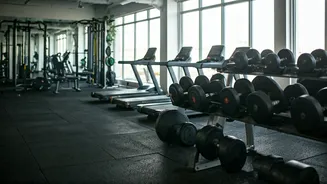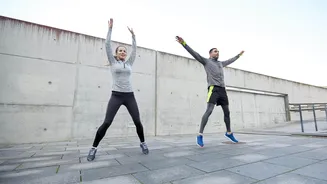Adjust Your Routine
Winter's chill shouldn't mean a complete halt to your fitness regime. It's essential to adjust your workout plan rather than abandon it. Consider switching
from outdoor runs to indoor gym sessions or home workouts. If you enjoy running, modify your routes, choosing well-lit paths to navigate safely. The shift in seasons allows for trying other activities like swimming, yoga, or indoor cycling, providing variety and preventing workout monotony. This adaptability ensures fitness remains a consistent part of your lifestyle even when conditions change.
Layer Up Smartly
Dressing appropriately is key to comfort and safety when exercising outdoors in winter. The principle of layering is crucial to regulate body temperature. Begin with a moisture-wicking base layer to draw sweat away from the skin. Add an insulating mid-layer, such as fleece or a lightweight jacket, to retain heat. The outermost layer should be wind-resistant and waterproof to protect against the elements. Accessories like gloves, hats, and scarves are non-negotiable for shielding against cold air. By using these layers, you can regulate your body temperature, staying warm, dry, and comfortable, even in chilly weather, therefore making your winter workouts much more enjoyable.
Mix Indoor & Outdoor
Don't let the weather limit you to a single workout environment. A balanced mix of indoor and outdoor activities can enhance your winter fitness routine. Combine indoor gym sessions, where you can focus on strength training or use cardio machines, with outdoor activities on milder days. Consider activities like brisk walking or jogging, but be mindful of icy conditions. Incorporating both types of exercises ensures you enjoy the benefits of fresh air and natural light while staying protected from the elements. This mix keeps workouts fresh and appealing.
Hydration Still Matters
Hydration is important year-round, but it's often overlooked during the winter. While you might not feel as thirsty in cold weather, your body still needs adequate fluids. Dry indoor air and the exertion of exercise can lead to dehydration. Carry a reusable water bottle and sip water consistently throughout the day, even before, during, and after workouts. Staying hydrated supports optimal performance, aids in recovery, and helps maintain overall health. Drinking enough water also helps to regulate body temperature, aiding in the body's internal processes and general well-being during the winter.
Warm Up Indoors First
Before braving the cold, it’s imperative to warm up your muscles indoors. Start with a series of dynamic stretches, such as arm circles, leg swings, and torso twists, to increase blood flow and prepare your muscles for activity. Avoid static stretches before your workout, as they can decrease muscle performance in the cold. Transition from indoor warm-ups to outdoor activities smoothly, allowing your body to acclimate gradually to the lower temperatures. A proper warm-up reduces the risk of injury and helps optimize your performance, making your winter workouts safer and more effective.
Prioritize Your Health
Prioritizing your health is essential when exercising in the winter. Listen to your body and adjust your plans based on how you feel. If the weather conditions are extreme, it's wiser to opt for indoor activities. Ensure you're getting enough sleep, as rest is crucial for muscle recovery and overall health. Maintain a balanced diet, including foods that provide essential nutrients and boost your immune system. Taking precautions like these will ensure that your winter fitness routine is both safe and enjoyable, promoting your well-being throughout the season. Proper self-care and attention to your health are key components of a successful winter exercise regime.













